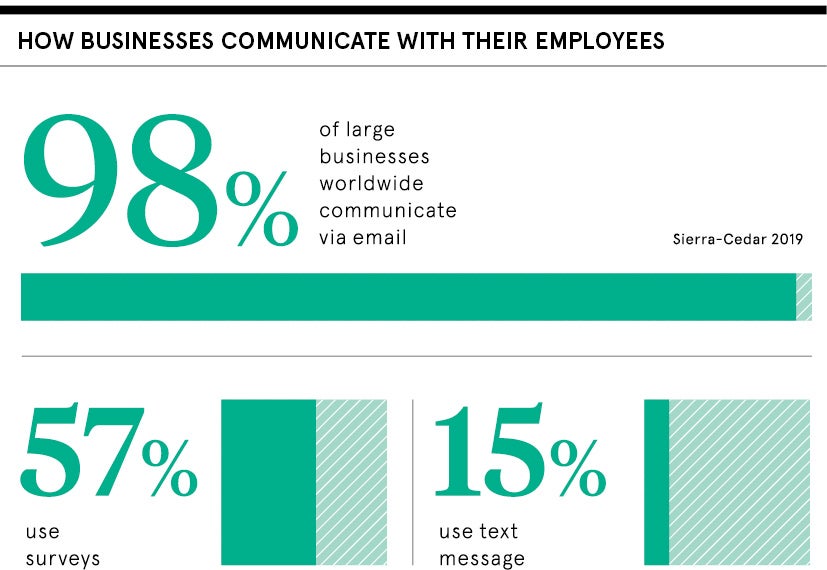The importance of creating a positive brand is well understood and a sophisticated industry to help businesses achieve this in the marketplace has flourished. But the idea of focusing on employer brand, through internal communication, is less well developed.
Lisa Pantelli, head of community at simply communicate, a group for internal communication specialists, explains: “There are two camps. Some organisations put it at the heart of what they do, how they operate, make business decisions and recruit and retain staff. But ‘employer brand’ has also become a bit of a buzzphrase, so senior leaders often say they want to go down this path without understanding what it really means.”
The concept of employer brand is essentially the workplace element of the company’s overall corporate brand reputation. It refers to the company’s image and standing as an employer, which includes its employer value proposition (EVP) or the reasons people choose to work for the organisation. The EVP incorporates everything from benefits and rewards to company culture and the overall employee experience.
As Pantelli says: “There’s a convergence, or blurring of the lines, with reputation management because what happens on the inside is reflected on the outside.” Unsurprisingly then, employer branding is perceived in some quarters as being increasingly important in attracting, engaging and retaining quality staff.
Jenni Field, director of consultancy Redefining Communications and president of the Chartered Institute of Public Relations, says: “People are starting to pay more attention as they realise they need to focus more on their employees after having forgotten about them for years. It’s an area that’s been around for quite a while now, so it’s not in its infancy; it just hasn’t matured yet.”
But going down this route can provide undoubted benefits. Firstly, creating a positive employer brand helps organisations differentiate themselves from their competitors, which can make all the difference in industries struggling to cope with talent shortages.
Employee loyalty equals customer loyalty
Secondly, a clearly communicated employer brand and brand values strengthen staff loyalty. This is because alignment with the company purpose, as well as helping people to understand why their role is important and how they fit into the overall picture, is empowering. It enables staff to perform more effectively, which in turn helps boost productivity and retention.
Heightened levels of employee loyalty also enhance external brand recognition and customer loyalty, says Susy Roberts, founder of people development consultancy Hunter Roberts, as it means staff present the brand at a personal level, which in turn generates feelings of connection and familiarity.

In other words, a sound internal communication strategy is just as important for brand recognition as any external activity. As a result, it is vital the organisation’s culture reflects what the brand stands for, thereby enabling employees to represent it effectively. For instance, if employee areas in the offices of a luxury brand are tatty and low quality, “people won’t be going into the customer environment with the mindset to deliver a premium service”, says Roberts.
“Everything about the customer journey needs to be mirrored in the employee journey, from the moment of recruitment to the point of sale.”
For example, the core brand message of Brunelcare, a charity with more than 2,200 employees that provides housing and support for older people in the south west of England, is that care is at the heart of what it does. The aim, therefore, is to demonstrate this ethos not just among its client populations, but also among its workforce.
One way of achieving this goal is to take internal communication activities seriously as “keeping staff informed makes them feel more valued”, says Stacey Byles, the charity’s public relations and marketing co-ordinator. This includes recognising and writing about its unsung heroes, in the shape of housekeepers, chefs and receptionists, “who are the vital cogs that keep the organisation ticking”, she adds.
Aligning company culture with employer brand
Another approach includes extensive skills training for all employees, into which the organisation’s brand messaging is embedded. Everyone is also encouraged to develop a pitch about what they and the charity do.
“It’s important we answer the question ‘so what do you do at Brunelcare?’ with poise and confidence,” says Byles. “We want people to be impressed, but also sense the passion from each and every person who works here.”
To ensure employer branding activities work effectively though involves a four-step process, says Pantelli at simplycommunicate. The first entails talking to stakeholders, which includes employees and customers, to obtain a clear picture of how the organisation is being described and talked about.
The second is about understanding the common thread from such discussions as it is this theme that will form the basis of your employer brand. As a result, it is important to present your findings back to employees for feedback both to understand how representative they truly are and also to ensure staff feel involved.
The third, enablement phase focuses on developing and implementing the requisite business objectives, operational processes, policies and culture to make your clear and concise narrative stick. Ongoing internal communication is vital as is employee advocacy.
The final stage, meanwhile, consists of continual listening and measurement as “employer branding should never be taken for granted”, Pantelli adds.
Roberts at consultancy Hunter Roberts agrees, but says ultimately success depends on a number of key factors, notably leadership commitment and the necessity of role-modelling the employer brand from the top down. Another is staff buy-in.
Employee loyalty equals customer loyalty






